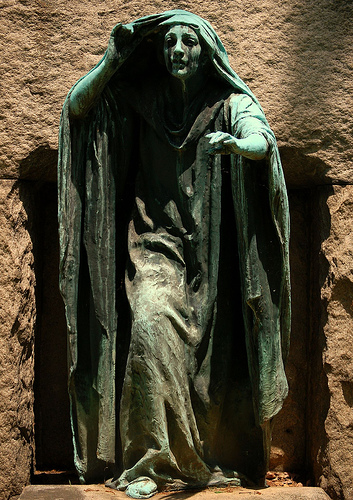"This site is marked by the bronze and stone monument, "Rabboni" by Gutzon Borglum. This depicts Mary Magdalene at the tomb of Christ on Easter Morning. Gutzon was the sculptor who designed Mount Rushmore."
http://www.foulke.org/history/bios/famous.shtml∼Investment banker and art collector. Charles M. Ffoulke began his career as a wool merchant in Philadelphia. In 1872, after making his fortune in that line of work, he began traveling the world studying and collecting antique tapestries. The most notable items in his collection included the famous 17th-century Barberini tapestries. He later settled in Washington, D.C., where he established an investment banking firm with his son. The Ffoulke home on Massachusetts Avenue near Dupont Circle was a center for social life in Washington at the turn of the century and included a separate ballroom-gallery for displaying his tapestries. Neighbors and friends included industrialist George Westinghouse and socialite Evalyn Walsh McLean. Much of his free time was spent educating others about European art; he was one of the early presidents of the National Society of the Fine Arts. Some of his Barberini tapestries are now displayed at New York's Cathedral of St. John the Divine and at the Philadelphia Museum of Art. Charles Ffoulke married Sarah Cushing in Paris in December of 1872. Three of their children died in their 20s of tuberculosis. Two daughters, Gladys and Helen, married and raised families of their own. After his death at the Hotel Le Marquis in New York City, Charles was buried in Washington, D.C., with his children and later his wife Sarah. The Ffoulke gravesite is marked by a bronze and stone monument titled "Rabboni," which was designed by famed sculptor Gutzon Borglum. It depicts Mary Magdalene emerging from the tomb of Christ.
"This site is marked by the bronze and stone monument, "Rabboni" by Gutzon Borglum. This depicts Mary Magdalene at the tomb of Christ on Easter Morning. Gutzon was the sculptor who designed Mount Rushmore."
http://www.foulke.org/history/bios/famous.shtml∼Investment banker and art collector. Charles M. Ffoulke began his career as a wool merchant in Philadelphia. In 1872, after making his fortune in that line of work, he began traveling the world studying and collecting antique tapestries. The most notable items in his collection included the famous 17th-century Barberini tapestries. He later settled in Washington, D.C., where he established an investment banking firm with his son. The Ffoulke home on Massachusetts Avenue near Dupont Circle was a center for social life in Washington at the turn of the century and included a separate ballroom-gallery for displaying his tapestries. Neighbors and friends included industrialist George Westinghouse and socialite Evalyn Walsh McLean. Much of his free time was spent educating others about European art; he was one of the early presidents of the National Society of the Fine Arts. Some of his Barberini tapestries are now displayed at New York's Cathedral of St. John the Divine and at the Philadelphia Museum of Art. Charles Ffoulke married Sarah Cushing in Paris in December of 1872. Three of their children died in their 20s of tuberculosis. Two daughters, Gladys and Helen, married and raised families of their own. After his death at the Hotel Le Marquis in New York City, Charles was buried in Washington, D.C., with his children and later his wife Sarah. The Ffoulke gravesite is marked by a bronze and stone monument titled "Rabboni," which was designed by famed sculptor Gutzon Borglum. It depicts Mary Magdalene emerging from the tomb of Christ.
Inscription
The top of the monument contains the following epitaph:
" The end of birth is death
The end of death is life and
Wherefore mournest thou"
Family Members
Sponsored by Ancestry
Advertisement
Explore more
Sponsored by Ancestry
Advertisement


















